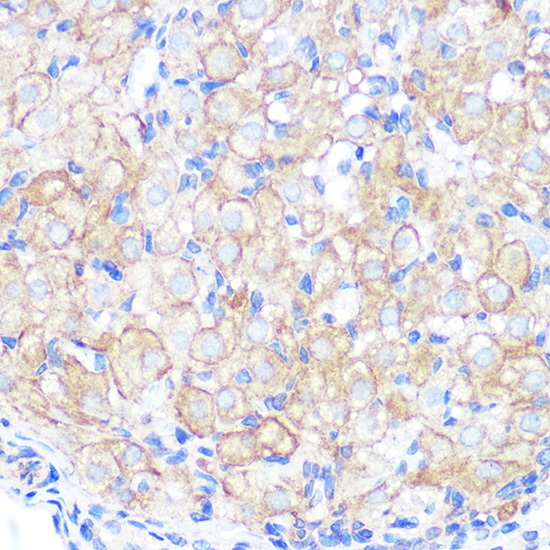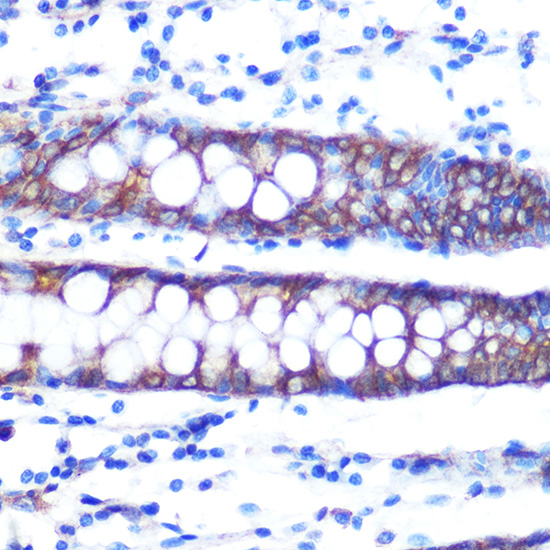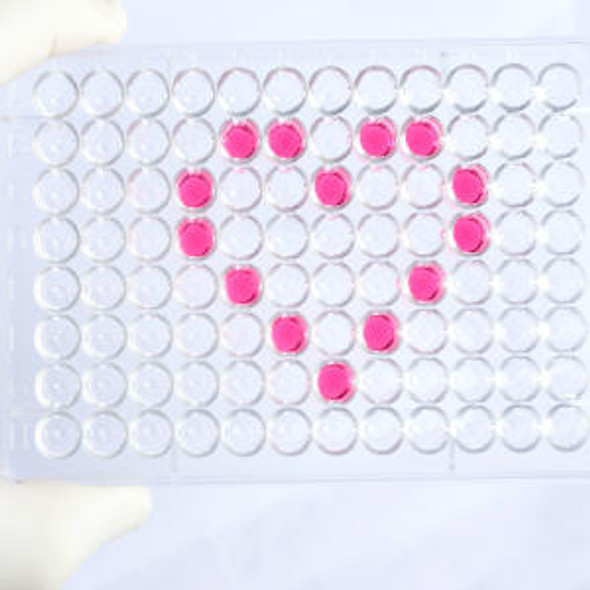Cell Biology Antibodies 8
Anti-Occludin Antibody (CAB2601)
- SKU:
- CAB2601
- Product Type:
- Antibody
- Reactivity:
- Human
- Reactivity:
- Mouse
- Reactivity:
- Rat
- Host Species:
- Rabbit
- Isotype:
- IgG
- Research Area:
- Cell Biology
Description
| Antibody Name: | Anti-Occludin Antibody |
| Antibody SKU: | CAB2601 |
| Antibody Size: | 20uL, 50uL, 100uL |
| Application: | WB IHC IF |
| Reactivity: | Human, Mouse, Rat |
| Host Species: | Rabbit |
| Immunogen: | Recombinant fusion protein containing a sequence corresponding to amino acids 263-522 of human Occludin (NP_002529.1). |
| Application: | WB IHC IF |
| Recommended Dilution: | WB 1:1000 - 1:2000 IHC 1:50 - 1:200 IF 1:50 - 1:200 |
| Reactivity: | Human, Mouse, Rat |
| Positive Samples: | 293T, Mouse brain, Mouse kidney, Mouse liver, Rat liver |
| Immunogen: | Recombinant fusion protein containing a sequence corresponding to amino acids 263-522 of human Occludin (NP_002529.1). |
| Purification Method: | Affinity purification |
| Storage Buffer: | Store at -20'C. Avoid freeze / thaw cycles. Buffer: PBS with 0.02% sodium azide, 50% glycerol, pH7.3. |
| Isotype: | IgG |
| Sequence: | FAVK TRRK MDRY DKSN ILWD KEHI YDEQ PPNV EEWV KNVS AGTQ DVPS PPSD YVER VDSP MAYS SNGK VNDK RFYP ESSY KSTP VPEV VQEL PLTS PVDD FRQP RYSS GGNF ETPS KRAP AKGR AGRS KRTE QDHY ETDY TTGG ESCD ELEE DWIR EYPP ITSD QQRQ LYKR NFDT GLQE YKSL QSEL DEIN KELS RLDK ELDD YREE SEEY MAAA DEYN RLKQ VKGS ADYK SKKN HCKQ LKSK LSHI KKMV GDYD RQKT |
| Gene ID: | 100506658 |
| Uniprot: | Q16625 |
| Cellular Location: | Cell junction, Membrane, Multi-pass membrane protein, tight junction |
| Calculated MW: | 8kDa/23kDa/31kDa/52kDa/54kDa/59kDa |
| Observed MW: | 59kDa |
| Synonyms: | OCLN, BLCPMG, PPP1R115, PTORCH1, occludin, Occludin |
| Background: | This gene encodes an integral membrane protein that is required for cytokine-induced regulation of the tight junction paracellular permeability barrier. Mutations in this gene are thought to be a cause of band-like calcification with simplified gyration and polymicrogyria (BLC-PMG), an autosomal recessive neurologic disorder that is also known as pseudo-TORCH syndrome. Alternative splicing results in multiple transcript variants. A related pseudogene is present 1.5 Mb downstream on the q arm of chromosome 5. |
| UniProt Protein Function: | occludin: May play a role in the formation and regulation of the tight junction (TJ) paracellular permeability barrier. It is able to induce adhesion when expressed in cells lacking tight junctions. Interacts with TJP1/ZO1 and with VAPA. Localized at tight junctions of both epithelial and endothelial cells. Highly expressed in kidney. Not detected in testis. Belongs to the ELL/occludin family. 7 isoforms of the human protein are produced by alternative splicing. |
| UniProt Protein Details: | Protein type:Motility/polarity/chemotaxis; Cell adhesion; Membrane protein, multi-pass; Membrane protein, integral Chromosomal Location of Human Ortholog: 5q13.1 Cellular Component: tight junction; endocytic vesicle; apicolateral plasma membrane; apical plasma membrane; integral to membrane; plasma membrane; cytoplasmic vesicle; intercellular junction; cytosol; cell junction Molecular Function:thiopurine S-methyltransferase activity; protein domain specific binding; protein binding; structural molecule activity Biological Process: methylation; intercellular junction assembly and maintenance; apoptosis; S-adenosylmethionine metabolic process; protein complex assembly; S-adenosylhomocysteine metabolic process; cell structure disassembly during apoptosis Disease: Band-like Calcification With Simplified Gyration And Polymicrogyria |
| NCBI Summary: | This gene encodes an integral membrane protein that is required for cytokine-induced regulation of the tight junction paracellular permeability barrier. Mutations in this gene are thought to be a cause of band-like calcification with simplified gyration and polymicrogyria (BLC-PMG), an autosomal recessive neurologic disorder that is also known as pseudo-TORCH syndrome. Alternative splicing results in multiple transcript variants. A related pseudogene is present 1.5 Mb downstream on the q arm of chromosome 5. [provided by RefSeq, Apr 2011] |
| UniProt Code: | Q16625 |
| NCBI GenInfo Identifier: | 3914196 |
| NCBI Gene ID: | 100506658 |
| NCBI Accession: | Q16625.1 |
| UniProt Secondary Accession: | Q16625,Q5U1V4, Q8N6K1, B5BU70, D2DU64, D2DU65, D2IGC0 D2IGC1, E2CYV9, |
| UniProt Related Accession: | Q16625 |
| Molecular Weight: | 522 |
| NCBI Full Name: | Occludin |
| NCBI Synonym Full Names: | occludin |
| NCBI Official Symbol: | OCLN |
| NCBI Official Synonym Symbols: | BLCPMG; PPP1R115 |
| NCBI Protein Information: | occludin; tight junction protein occludin; phosphatase 1, regulatory subunit 115 |
| UniProt Protein Name: | Occludin |
| Protein Family: | Occludin |
| UniProt Gene Name: | OCLN |
| UniProt Entry Name: | OCLN_HUMAN |









